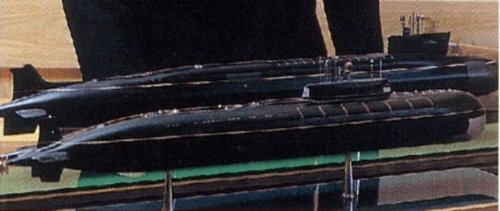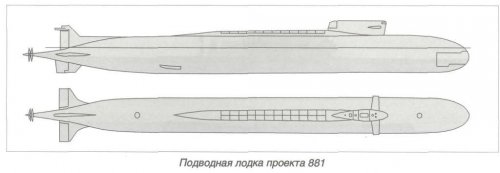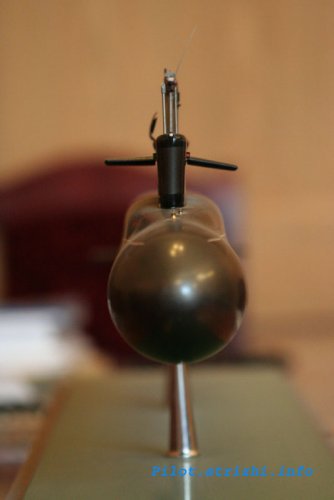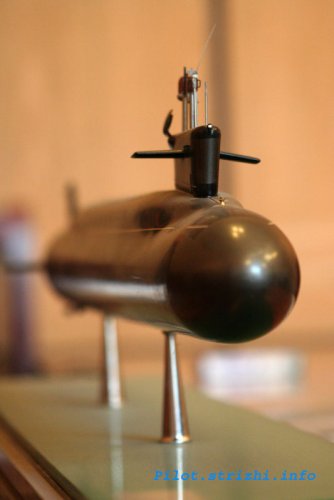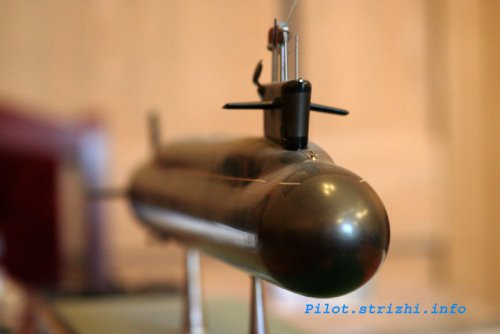In the mid 1980s, the Soviet Navy determined that a new weapon system was needed to deal with the ever-increasing power of US Navy carrier battle groups. At the time, the Project 949 (Granit) and Project 949A (Antey), NATO reporting names Oscar I and Oscar II, nuclear-powered guided missile submarines (SSGN) did not seem sufficiently effective over the long term. As a result, TsKB Rubin began work on the Project 881 nuclear-powered guided missile submarine, codenamed Merkuriy (Mercury), under the leadership of Chief Designer IL Baranov.
The submarine was intended to use the then in development Bolide anti-ship missile, which was a further development of the P-700 Granit, NATO reporting name SS-N-19 Shipwreck, with the range increased to 800 km (432 nm, 497 m). The submarine was to be armed with 24 of these missiles housed in inclined launchers. As a result, Project 881 grew enormously and became equal in size to a nuclear-powered ballistic missile submarine. Length is estimated at 170 to 180 meters, 558 ft to 591 ft, with an underwater displacement of at least 25,000 tons, which would have made it the largest underwater carrier of tactical weapons in the world.
The design of Merkuriy almost completely corresponded to the draft of the Project 935, Borey?, nuclear-powered ballistic missile submarine except for a large hump concealing the upper part of the missile launchers. The Irtysh-Amphora sonar system, which was to be standard for the fourth generation boats, was housed in the bow of the boat. Besides forward antenna were located the large onboard of sonar antennas, similar established on Projects 885 and 09780 Axon-2, on which they tested. Six torpedo tubes, supposedly of the 533 mm diameter, were to be arranged immediately after the bow sonar complex. The tail assembly was a standard cross-shaped configuration.
The Merkuriy project was canceled in 1989.
Despite the cancellation of the Merkuriy project, work on the Bolide anti-ship missile continued. On July 9, 1990 it was decided to conduct joint flight tests of the Bolide missile and to re-equip the first boat of the Project 949 class, Arkhangelsk (K-525), for this purpose. The Bolide missile system was intended to arm the Project 949B Atlas class, whose series was to begin immediately after the completion of the last Project 949A class boats Belgorod , Volgograd, and Barnaul. These plans were disrupted stemming from the collapse of the USSR and the ensuing economic crisis.
Based on a translation by Ender at the Warship Projects Discussion Boards 3.0 forum.
http://www.phpbbplanet.com/warshipprojects/viewtopic.php?t=3299&mforum=warshipprojects
From an original post in Russian:
http://paralay.iboards.ru/viewtopic.php?f=9&t=945&sid=2993d3d98e41e17b0f53242645724eac
Photograph of Project 949 model alongside Project 881 model.
Line drawing of Project 881 nuclear-powered cruise missile submarine.
The submarine was intended to use the then in development Bolide anti-ship missile, which was a further development of the P-700 Granit, NATO reporting name SS-N-19 Shipwreck, with the range increased to 800 km (432 nm, 497 m). The submarine was to be armed with 24 of these missiles housed in inclined launchers. As a result, Project 881 grew enormously and became equal in size to a nuclear-powered ballistic missile submarine. Length is estimated at 170 to 180 meters, 558 ft to 591 ft, with an underwater displacement of at least 25,000 tons, which would have made it the largest underwater carrier of tactical weapons in the world.
The design of Merkuriy almost completely corresponded to the draft of the Project 935, Borey?, nuclear-powered ballistic missile submarine except for a large hump concealing the upper part of the missile launchers. The Irtysh-Amphora sonar system, which was to be standard for the fourth generation boats, was housed in the bow of the boat. Besides forward antenna were located the large onboard of sonar antennas, similar established on Projects 885 and 09780 Axon-2, on which they tested. Six torpedo tubes, supposedly of the 533 mm diameter, were to be arranged immediately after the bow sonar complex. The tail assembly was a standard cross-shaped configuration.
The Merkuriy project was canceled in 1989.
Despite the cancellation of the Merkuriy project, work on the Bolide anti-ship missile continued. On July 9, 1990 it was decided to conduct joint flight tests of the Bolide missile and to re-equip the first boat of the Project 949 class, Arkhangelsk (K-525), for this purpose. The Bolide missile system was intended to arm the Project 949B Atlas class, whose series was to begin immediately after the completion of the last Project 949A class boats Belgorod , Volgograd, and Barnaul. These plans were disrupted stemming from the collapse of the USSR and the ensuing economic crisis.
Based on a translation by Ender at the Warship Projects Discussion Boards 3.0 forum.
http://www.phpbbplanet.com/warshipprojects/viewtopic.php?t=3299&mforum=warshipprojects
From an original post in Russian:
http://paralay.iboards.ru/viewtopic.php?f=9&t=945&sid=2993d3d98e41e17b0f53242645724eac
Photograph of Project 949 model alongside Project 881 model.
Line drawing of Project 881 nuclear-powered cruise missile submarine.

